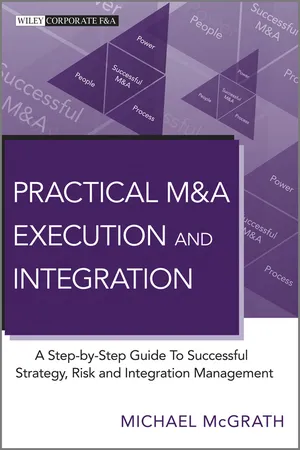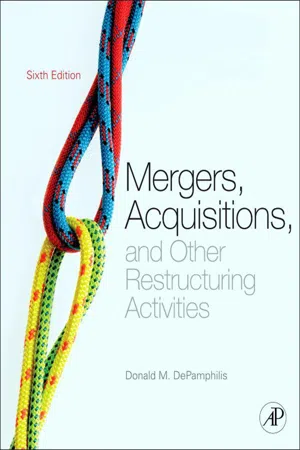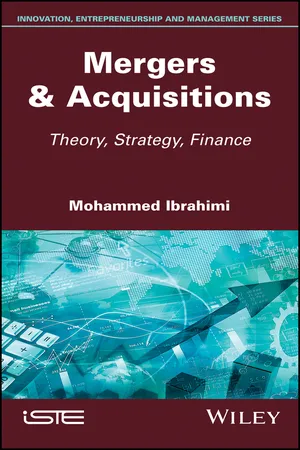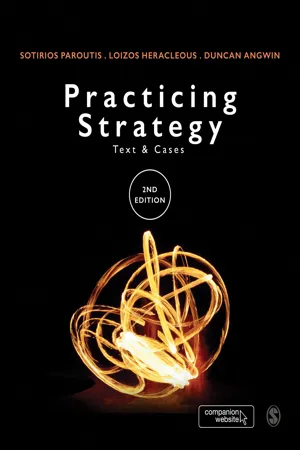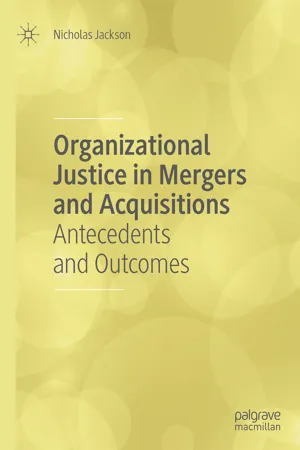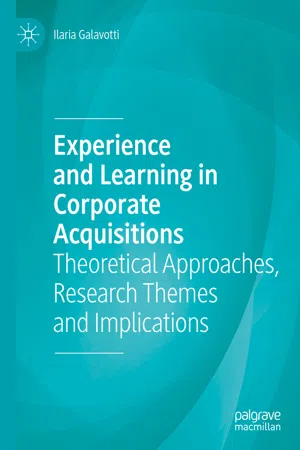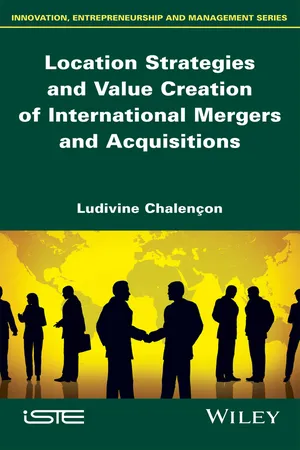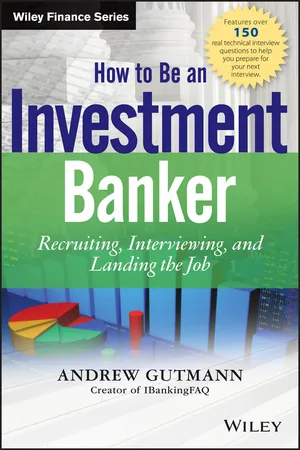Business
Mergers and Acquisitions
Mergers and acquisitions refer to the consolidation of companies through various financial transactions, such as mergers, acquisitions, and takeovers. These activities are aimed at achieving synergies, expanding market share, and increasing shareholder value. Mergers involve the combination of two companies to form a new entity, while acquisitions involve one company purchasing another.
Written by Perlego with AI-assistance
Related key terms
Related key terms
1 of 4
Related key terms
1 of 3
12 Key excerpts on "Mergers and Acquisitions"
- eBook - ePub
Practical M&A Execution and Integration
A Step by Step Guide To Successful Strategy, Risk and Integration Management
- Michael R. McGrath(Author)
- 2011(Publication Date)
- Wiley(Publisher)
If you are already versed in this field, you might feel a temptation to skip some or all of this section. Whilst that is your prerogative I would encourage you to at least browse this section as it provides the framework for the remainder of the book.Each one of these capabilities is described and explored in greater depth later in the book. Failure to possess any of these capabilities is the surest route to M&A failure. In providing an introduction to M&A we will examine the types of M&A deals that can occur and the structure of an M&A through its lifecycle; we will present current trends in M&A and consider what the future may hold.FUNDAMENTALS OF Mergers and Acquisitions Before embarking on any discussion there are a few points in relation to M&A you need to be aware of:- Volumes (the number of deals) and values (the price of those deals) of M&A deals have tended to grow over time. But they usually grow in waves rather than continuously.
- People tend to get emotional about them, for many good reasons, but this can distract and cloud judgement.
- They are very complex.
- They can have a tremendous impact on the organisation.
- Most importantly, they are very risky, and as a consequence they are prone to failure.
When people talk about Mergers & Acquisitions what are they really talking about? M&A is a collective description for a series of related corporate activities with the purpose of leading one or more, or sometimes parts of, companies to the change of control stage. A merger is when two organisations agree to come together to form a new enhanced merged organisation. The resources, assets and liabilities form the new company. The ownership of the merged organisations is shared among the combined owners. In effect each individual owner agrees to be a relatively smaller fish in a bigger pool. An acquisition, on the other hand, is when the ownership of a company is transferred, in full or in part, to the acquiring firm. In turn, the acquiring firm rewards the owners of the acquired firm by paying for the acquired company. This payment can be made in a number of ways, the most common being cash or shares (stock), or a combination of the two. There is great variety in M&A activity and no ‘standard form’. Later in this section we will see the rich variety of activities that can occur. The M&A activities can also include demergers, sometimes called a ‘sell off’, ‘split’ or ‘break up’. A demerger is where a company splits part of its business away to become a separate unit which can be sold. - David P. Stowell(Author)
- 2012(Publication Date)
- Academic Press(Publisher)
4
Mergers and Acquisitions
The material in this chapter should be cross-referenced with this case: The Best Deal Gillette Could Get? Proctor & Gamble’s Acquisition of Gillette.Corporate change of ownership transactions or combinations such as mergers, acquisitions, divestitures, and joint ventures (collectively, “M&A”) are important strategic considerations for companies that are contemplating ways to enhance shareholder value or reduce shareholder risk. Investment bankers play a key role in initiating, valuing, and executing M&A transactions. This activity accounts for a substantial portion of revenue generated by the Investment Banking Division within large investment banks and represents most of the revenue at certain boutique investment banks.M&A is a global business, with approximately half of all transactions completed inside the United States (see Table 4.1 ). Virtually no major company or industry across the globe is unaffected by M&A transactions.Table 4.1 Mergers and Acquisitions League TablesThe Core of M&A
At the core of M&A is the buying and selling of corporate assets in order to achieve one or more strategic objectives. Before entering into an acquisition, companies typically compare the costs, risks, and benefits of an acquisition with their organic opportunity (often referred to as a “Greenfield analysis”). This buy versus build analysis is an important departure point for a company as it begins to think about an acquisition. Is it better to build a brand, geographic coverage, distribution network, installed base of products or services, and relationships? Or is it better to acquire them? Obviously, time, expense, and assessment of risk play a key role in this decision.The analysis is never static. Strategic decisions must be reevaluated in light of new circumstances. The success or failure of competitors, the changing costs of capital, and pricing of public assets all come into play and constantly alter the equations.- eBook - ePub
Mergers, Acquisitions, and Other Restructuring Activities
An Integrated Approach to Process, Tools, Cases, and Solutions
- Donald DePamphilis(Author)
- 2011(Publication Date)
- Academic Press(Publisher)
PART II
The Mergers and Acquisitions Process: Phases 1 through 10
Introduction Chapter 4 Planning: Developing Business and Acquisition Plans Chapter 5 Implementation: Search through Closing Chapter 6 IntegrationPassage contains an image
Introduction
Courtesy ofwww.CartoonStock.com.Part II views Mergers and Acquisitions not as business strategies but rather as a means of implementing business strategies. Business strategies define a firm's vision and long-term objectives and how it expects to achieve these ends. M&As simply represent one means of implementing the business strategy. The firm may choose from a range of reasonable alternative implementation strategies, including “going it alone” or partnering, or by acquiring another firm.Chapters 4 through 6 discuss the various activities often undertaken in a merger or acquisition. These activities comprise the ten phases of an M&A process. While not all Mergers and Acquisitions unfold in exactly the same way, the process outlined in this section serves as a road map for executing such transactions. The process is sufficiently flexible to be applicable to alternatives to M&As such as business alliances, which are discussed in Chapter 14 .Chapter 4 focuses on how to develop a business plan or strategy and, if an acquisition is viewed as the best way of realizing the business strategy, how to develop an acquisition plan. Chapter 5 deals with identifying, making initial contact with the potential target, and developing the necessary legal documents prior to beginning due diligence and formal negotiations. While initial valuations provide a starting point, the actual purchase price is determined during the negotiation period. If agreement can be reached, planning the integration of the target firm begins between the signing of the purchase agreement and the closing. The motivation for each phase of the process is discussed in detail. Chapter 6 - eBook - ePub
Mergers & Acquisitions
Theory, Strategy, Finance
- Mohammed Ibrahimi(Author)
- 2018(Publication Date)
- Wiley-ISTE(Publisher)
et al. [MAQ 98] observed that significant value is only created in horizontal mergers/acquisitions involving companies operating within the same market. Finally, we note that the multiplication of risky Mergers and Acquisitions can lead to the destruction of value, leading the company to divest assets in order to specialize and focus on niche products.1.1.2. Vertical Mergers and Acquisitions1.1.2.1. Definition of vertical Mergers and AcquisitionsVertical acquisition strategies are used by companies wishing to master the whole of their economic chain, involving a company and its supplier or a client. This form of growth can concern any stage of the product creation processor and may result from the addition of activities complementary to the company’s main activity. The company may take a step up the chain of production, producing something previously bought in from a supplier, or move down the supply chain, controlling the destination of its products. This strategy is suitable for specialized firms wishing to gain a stronger footing, and for firms which are subject to anti-trust laws. According to Seth [SET 90b], it also constitutes the second main option for related diversification.Supplier acquisition is a form of upstream integration. It enables better control of the supply chain, with full control of efficiency, delivery times and quality. Client acquisition, on the other hand, is a form of downstream acquisition, allowing the company to guarantee that products will be distributed in line with its specific requirements. Full vertical integration combines both elements, with the buyer company at the center of a new organization, with full mastery of the whole production chain. Both forms of integration add value at each stage of production. They enable better distribution of fixed charges across the whole production chain. The profit margin taken by the supplier or client is cancelled, to the benefit of the buyer, and the company moves one step closer to the final consumer. - eBook - ePub
Practicing Strategy
Text and cases
- Sotirios Paroutis, Loizos Heracleous, Duncan Angwin(Authors)
- 2016(Publication Date)
- SAGE Publications Ltd(Publisher)
10 Practicing Strategy across Firms: Insights from M&AsLearning Objectives
- Examine the application of practice-related concepts to the study of Mergers and Acquisitions.
- Demonstrate that Mergers and Acquisitions provide an interesting, although complex, context within which to study the practicing of strategy.
- Understand the stages through which Mergers and Acquisitions happen and how these stages can be examined through a practice perspective.
- Raise awareness that M&A practices involve a shifting web of strategy actors spanning many organizational and institutional boundaries.
10.1 Introduction
How to grow companies to protect and enhance their competitive position in an increasingly turbulent world is of key concern to management and company stakeholders. An array of growth options exists from organic expansion through hybrid arrangements such as strategic alliances to full ownership where Mergers and Acquisitions (M&A) is often the preferred strategy. Each strategic option has important implications for the way in which organizations engage with their contexts and have implications for the work of strategists. This chapter focuses on strategy practices for a particular growth strategy – M&A, as it is a strategy context of great importance to organizations, economies, industries, regions, and a wide range of stakeholders (Angwin, 2007). Although the following discussion is specific to M&A there are many resonances with other expansion strategies, such as joint ventures and other types of strategic alliance, as strategy practitioners need to engage with a number of evolving contexts. Through the discussion the chapter will show how strategy practice(s) occur within a coexistent and fluid interplay between contexts.It is worth focusing upon M&A as a strategy practice context as over half a century of research has revealed its importance to a wide variety of stakeholders at different levels and geographies (Angwin, 2007). In dollar terms 2014 alone witnessed in excess of $3.5 trillion of M&A – an amount greater than the entire GDP of France in the same year, the worlds fifth largest economy. With M&A now a global phenomenon many new questions are being raised about how to select appropriate targets, transact deals and manage integration to enhance strategic advantage, but one core issue persists – why do 50% of all M&A fail? To constantly observe that M&A outcome is no better than a stochastic process is to undermine the value of top managers in this endeavor, investors and markets who support the activity, and raises significant questions about the value of research efforts to improve the situation. The burning question of why so many M&A take place, when 50% fail, has driven scholars from a wide range of disciplines, most notably finance, economics, strategy, organizational behavior, human resources, and psychology, to attempt to find answers to this problem. Each has focused on particular aspects of M&A, identifying important aspects from the perspective of a single discipline (Angwin, 2007). However, for the level of research effort expended, the amount of unequivocal findings remains disappointingly small (Grant, 2002) and many are so broad as to be of little value to practitioners. Indeed, despite half a century of research focusing upon M&A, the results are disappointing and there is even some empirical evidence that the failure rate of M&A is increasing. - eBook - ePub
Mergers and Acquisitions
The Critical Role of Stakeholders
- Helén Anderson, Virpi Havila, Fredrik Nilsson, Helén Anderson, Virpi Havila, Fredrik Nilsson, Helén Anderson, Virpi Havila, Fredrik Nilsson(Authors)
- 2012(Publication Date)
- Routledge(Publisher)
This type of situation may influence the acquiring and the target companies' relationships in a radical way. For example, relationships with suppliers and customers of the merging/acquiring companies may be terminated because of the merger/acquisition (Havila and Salmi 2000; Salmi, Havila, and Anderson 2001). On the other hand the companies' relationships may stay unchanged. The reason may be management skills in handling the situation or the view of stakeholders that they need not react if business continues as usual. All in all, this means that a merger or an acquisition is always challenging for management (Bower 2001).As we focus on a context with at least two companies, it will always be necessary to consider stakeholders of the same stakeholder category in both the acquiring and target company. To illustrate the multiplicity and diversity of stakeholder relationships during a merger or an acquisition, we apply a multi-stakeholder approach . We argue that a merger or an acquisition involves several stakeholder groups of both the acquirer and the target company. These stakeholder groups perceive the pro's and con's from their own perspective and thus act and react accordingly. Their stakes are unlikely to be the same. Further, they will probably evaluate the benefits and drawbacks of the merger process, and thus the changing stakes, in different ways.Figure 1.1 A merger or an acquisition involves at least two companies.Mergers and Acquisitions: FREQUENT STRATEGIC ACTIVITIES
Although the number of Mergers and Acquisitions seems to increase and decrease in waves (Martynova and Renneboog 2008; Shleifer and Vishny 1991), they have always been common and frequently studied. For example, according to Cartwright and Schoenberg (2006), an acquisition was made every 18 minutes all year around in 2004. Normally no business day ends without news of a merger or an acquisition in the media. It may be rumours of well-known global companies acquiring shares in each other, or it may emanate from a press conference where the CEO and the chairperson announce a merger. Whether the information is based on facts or just rumours, it still makes the headlines. The reason is simple: few other decisions and actions by shareholders, boards of directors and top management have such an impact on the company's future, on market structure and on shareholder value. Researchers who focus on mergers between two (or more) companies, or on acquisitions where the acquiring company acquires a substantial part of the shares in the target company, often see the merger/acquisition as a strategic step. In this introductory chapter, we present a brief overview of this broad field of research. - eBook - ePub
Organizational Justice in Mergers and Acquisitions
Antecedents and Outcomes
- Nicholas Jackson(Author)
- 2018(Publication Date)
- Palgrave Macmillan(Publisher)
Part I Mergers and AcquisitionsPassage contains an image
© The Author(s) 2019 Nicholas Jackson Organizational Justice in Mergers and Acquisitions https://doi.org/10.1007/978-3-319-92636-0_1Begin Abstract1. Introduction
End AbstractNicholas Jackson1(1) Leeds University Business School, Leeds, West Yorkshire, UKNicholas Jackson1.1 Emerging Patterns and Trends
The popularity of Mergers and Acquisitions (M&A) as a development strategy has increased significantly over the past 25 years, due in part to an ongoing pressure for organizations and companies to continuously renew and change themselves in an attempt to remain competitive and innovative. When considering opportunities for growth, Johnson, Scholes, and Whittington (2011 ) define three forms of developmental strategy for organizations: internal development, acquisition, and alliances. In comparison to other developmental growth strategies, Horwitz et al. (2002 ) recognize that M&A can offer an enticing range of competitive advantages that organic growth cannot achieve. They cite as major advantages the acquisition of new capabilities and resources in addition to the potentially unrivaled opportunity for costcutting. Furthermore, they provide greater control than the alternative options of licensing or forming alliances (King, Dalton, Daily, & Covin, 2004 ). It is therefore recognized that this form of integration has potential to offer several benefits for organizations and when compared to alternative strategies, such as organic growth or an alliance, the ability to grow the organization with an almost immediate effect.If we consider merger trends over recent times, both the number of deals and financial value show the growth pattern which corresponds with a period of increasing economic globalization and significant rises in foreign direct investment. Within this context of globalization and subsequent intensification of competitiveness, M&A became the dominant mode of firm growth in the 1980s and 1990s for both European and U.S. firms (see Capron, 2004 ; Berggren, 2003 ; Hayward, 2002 ). In part recognition of this, there is a considerable body of research that examines M&A and their consequences. As Fig. 1.1 shows, there was a substantial increase during the period 1998–2000 and then an equally rapid decline during the years 2001–2003. This coincides with a period of considerable economic expansion and subsequent contraction in global markets and corporate valuations. The incline continued again in 2004 until 2007 when, due to the global financial crisis in the following year, there was a severe decline in corporate valuations. It is noticeable that even so, after an initial decline, the number of deals has continued in strength.Fig. 1.1Global merger and acquisition deals. (Note: Based on data presented by Thomson One Banker (2017 - eBook - ePub
Experience and Learning in Corporate Acquisitions
Theoretical Approaches, Research Themes and Implications
- Ilaria Galavotti(Author)
- 2018(Publication Date)
- Palgrave Macmillan(Publisher)
© The Author(s) 2019 Ilaria Galavotti Experience and Learning in Corporate Acquisitions https://doi.org/10.1007/978-3-319-94980-2_3Begin Abstract3. Mergers and Acquisitions as Strategic Decisions
End AbstractIlaria Galavotti1(1) Università Cattolica del Sacro Cuore, Piacenza, ItalyIlaria Galavotti3.1 Mergers and Acquisitions Among Strategic Decisions: Distinctive Characteristics
The argument that the firm, rather than being considered as just an autonomous administrative unit, should rather be regarded as a collection of productive resources, whose disposal and allocation depend upon administrative decisions, dates back to Penrose’s Theory of the Growth of the Firm (1959 ). In her seminal work, she emphasizes that the long-term profitability of the firm is closely related to the growth opportunities that allow a more efficient use of resources, that is, both tangible and intangible assets semi-permanently tied to the firm.Mergers and Acquisitions (M&A) are considered among the most important strategic decisions for resource allocation (Wally and Robert Baum 1994 ), but, compared to other investment decisions, they show peculiar risk characteristics in virtue of their huge resource requirements and their considerable performance implications (Haspeslagh and Jemison 1991 ).A first distinctive characteristic of acquisitions compared to other resource - Ludivine Chalençon(Author)
- 2017(Publication Date)
- Wiley-ISTE(Publisher)
This chapter presented the main characteristics of Mergers and Acquisitions as well as the location of current operations. The term “Mergers and Acquisitions” aggregates multiple external growth strategies of various forms and motivations. Mergers and Acquisitions, moreover, constitute a mode of entry of choice for companies willing to enter into a foreign market. This is an often expressed motivation for this type of company association. Indeed, Mergers and Acquisitions enable companies to establish themselves more rapidly on a foreign market and to benefit from the competitive advantages that come with the location in the Dunning’s model sense. Companies from mature countries seem to establish themselves in emerging countries for reasons of exceptionally high opportunities for growth offered by these economies. Such ways of internationally expanding, however, involve a high level of risk. Throughout the development of this chapter, the current activity of Mergers and Acquisitions was detailed. We highlighted the great dynamism of French companies in that domain: at the world level, this country comes third in terms of merger and acquisition activity.The literature review we then presented shows the significance of dimensions of geographic distance, economic growth, quality of institutions and cultural differences. All these dimensions influence the chosen modes of entry as well as the risks incurred by companies that endeavor to internationalize. However, little research work has studied them in combination in order to assess their influence on the decision of companies to conduct a merger and acquisition in emerging countries rather than in mature countries. We therefore chose to focus on them in order to estimate the determining factors of the decision to conduct Mergers and Acquisitions in emerging or mature countries. We chose to operationalize these dimensions with one indicator only, especially because the various indicators associated with a single variable are often correlated. Although the French market appears very dynamic in terms of Mergers and Acquisitions, little research has been carried out on these operations. This discrepancy is one of the reasons why we chose to focus our research on French acquirers.- eBook - ePub
How to Be an Investment Banker
Recruiting, Interviewing, and Landing the Job
- Andrew Gutmann(Author)
- 2013(Publication Date)
- Wiley(Publisher)
Now let's put our investment banker hat back on. That many deals wind up destroying shareholder value instead of creating it is of utmost importance to management teams, to asset managers, and to hedge fund analysts. But not to investment bankers. We do not talk about this subject when we pitch M&A deals. Always remember that, to a banker, all deals are good deals. So forget what you just learned until you are working on the buy side.Mechanics of M&AIn this section, we will talk about the mechanics of an M&A transaction. In order words, what are the legal ways in which a company can actually buy another company? This is a topic that is highly specialized and, in a real transaction, best left to the M&A attorneys. However, as a banker, you should have at least a very basic understanding of the mechanics for how an acquisition is effectuated.We can categorize the ways in which to acquire a company into three types. An acquirer can do a merger, pursue a tender offer, or purchase assets. The first two of these types involve a company buying the equity or shares of the target. Normally the goal is to acquire 100 percent of the outstanding shares. In the third method, the acquirer purchases only assets from the target and not shares. Whether a company buys equity or buys assets has a number of tax consequences, which we will also briefly mention.Before we continue there is one final clarification worth making. As we have in this book, and as is customary in the industry, we use the term “Mergers and Acquisitions” (or M&A) to classify any transaction whereby one company mergers with or acquires another. Beyond the legal differences, a few of which we will discuss, there are no practical differences between a merger and an acquisition from the standpoint of an investment banker.MergerA merger (also known as a single-step or one-step merger) is a type of transaction whereby the acquirer purchases the stock of the target from the target's shareholders. For reasons that should become obvious, a merger is generally used in friendly transactions and not for hostile or unsolicited deals. - eBook - ePub
The Art of Capital Restructuring
Creating Shareholder Value through Mergers and Acquisitions
- H. Kent Baker, Halil Kiymaz, H. Kent Baker, Halil Kiymaz(Authors)
- 2011(Publication Date)
- Wiley(Publisher)
Moreover, scholars should distinguish the organizational level from the individual level. Acquiring firms, target firms, the combination of the two, investment bankers, and business consulting firms represent the organizational level, while employees and customers represent the individual level. Because each takes part in the acquisition process with different motives and at different times, this distinction should be incorporated when measuring acquisition performance.How Is M&A Performance Measured?The operationalization of performance construct and the method employed in M&A studies can be considered different sides of the same coin. To date, M&A scholars have generally used cross-sectional data. Granted the process nature of M&As (Jemison and Sitkin, 1986), longitudinal research could provide a proper approach to address questions of causality, produce a clearer understanding of the dynamic and ongoing nature of change processes, allow identifying contextual constraints, and aid in designing effective implementation plans (Van de Ven, 2007). Thus, process data and models can effectively cope with the multiple time scales that often occur in postmerger processes.SUMMARY AND CONCLUSIONSThis chapter applies a process approach for analyzing M&As. Consistent with such an approach, the chapter examines what happens after a deal is signed, because M&As do not end with signing a deal. The potential benefits of M&As materialize during the integration process. Thus, the handling of this process can largely determine whether M&As are successful.Integrating two companies into a single one is difficult. Because each M&A is unique, the route the acquiring firm chooses to implement changes depends on many contextual factors. Integrating mechanisms and a consistent communication plan are essential to attaining management's goals in an M&A. Both integrating tools and effective leadership are important to the success of M&As. Integration leaders play a key role in reaping benefits from the transaction. - eBook - ePub
The Essential CFO
A Corporate Finance Playbook
- Bruce P. Nolop(Author)
- 2012(Publication Date)
- Wiley(Publisher)
How will this transaction advance our strategic objectives?Only after CFOs can answer these threshold questions convincingly, should they turn to the projected financial impacts of the proposed transaction—to confirm that it makes economic as well as strategic and business sense. This requires stepping back from the specifics of the transaction and focusing on the basic objectives being pursued—in other words, clarifying the underlying strategic rationale for the transaction.TYPES OF ACQUISITIONS It usually helps to consider the rationale within the broad categories that describe the types of acquisitions that can be pursued: consolidations, bolt-ons, platforms, and transformations. Consolidation Transactions“Consolidations” usually reflect a recurring business pattern whereby an industry matures and then the industry participants seek increased market share and efficiencies through combinations with each other. The consolidations can occur through mergers between major companies (such as the recent experience in the banking and telecom industries) or through a roll-up of smaller companies in a fragmented industry (such as the consolidation trends in the printing and other service industries). Consolidations may reflect cross-border synergies on a global scale, or they may be contained within a specific country or geographical region.Although consolidations generally have ample potential to produce efficiencies through greater economies of scale, they also can be difficult to execute due to the incompatibility of cultures, information technology systems, or compensation and benefits programs; and they often are accompanied by revenue dis-synergies as customers choose to maintain a diversity of choices among their suppliers. Also, to obtain regulatory approvals, the acquirer may be required to divest some of the operations, thereby losing a portion of the projected benefits from the transaction.
Index pages curate the most relevant extracts from our library of academic textbooks. They’ve been created using an in-house natural language model (NLM), each adding context and meaning to key research topics.
Explore more topic indexes
Explore more topic indexes
1 of 6
Explore more topic indexes
1 of 4
